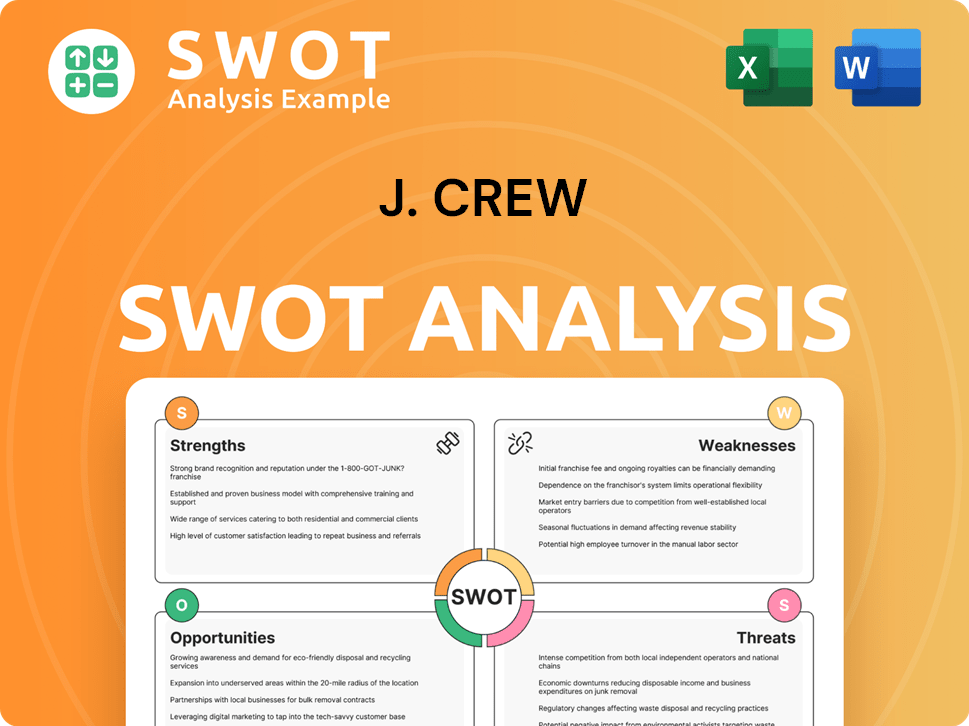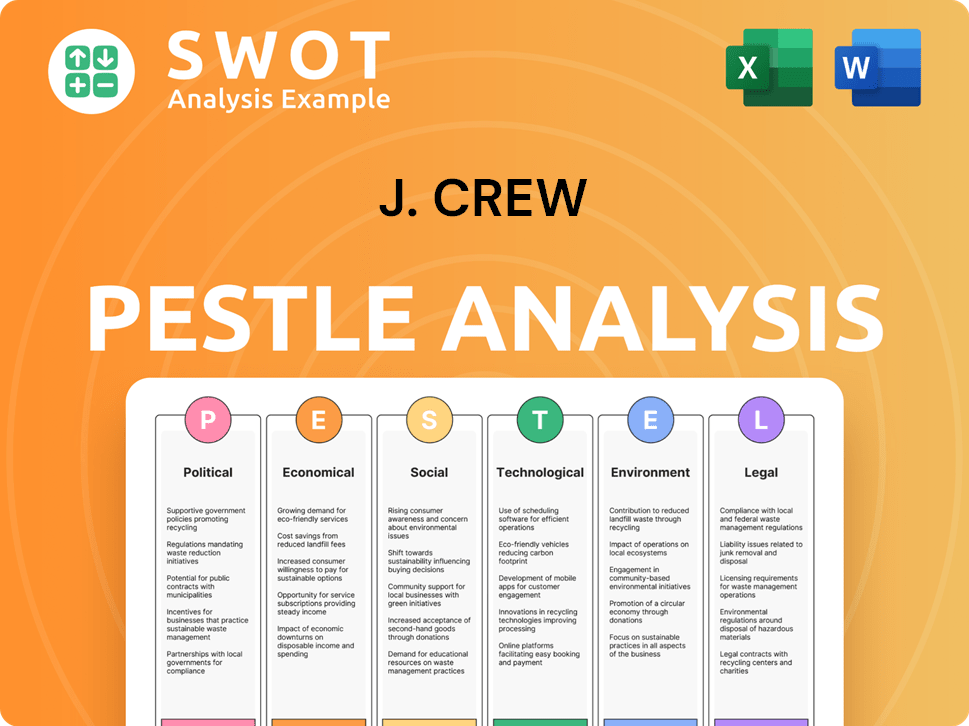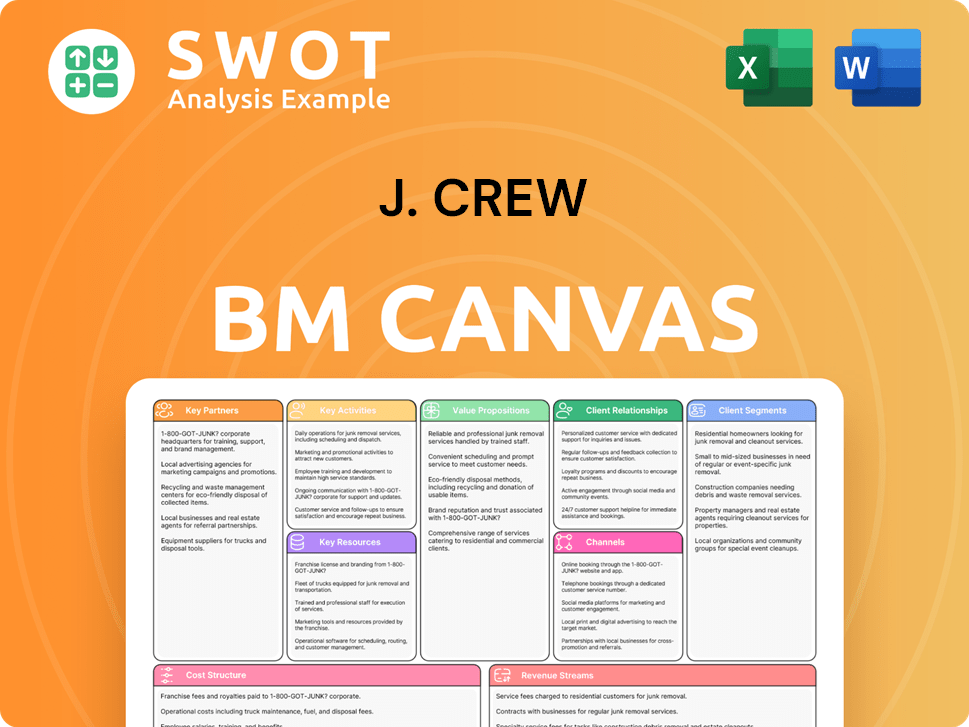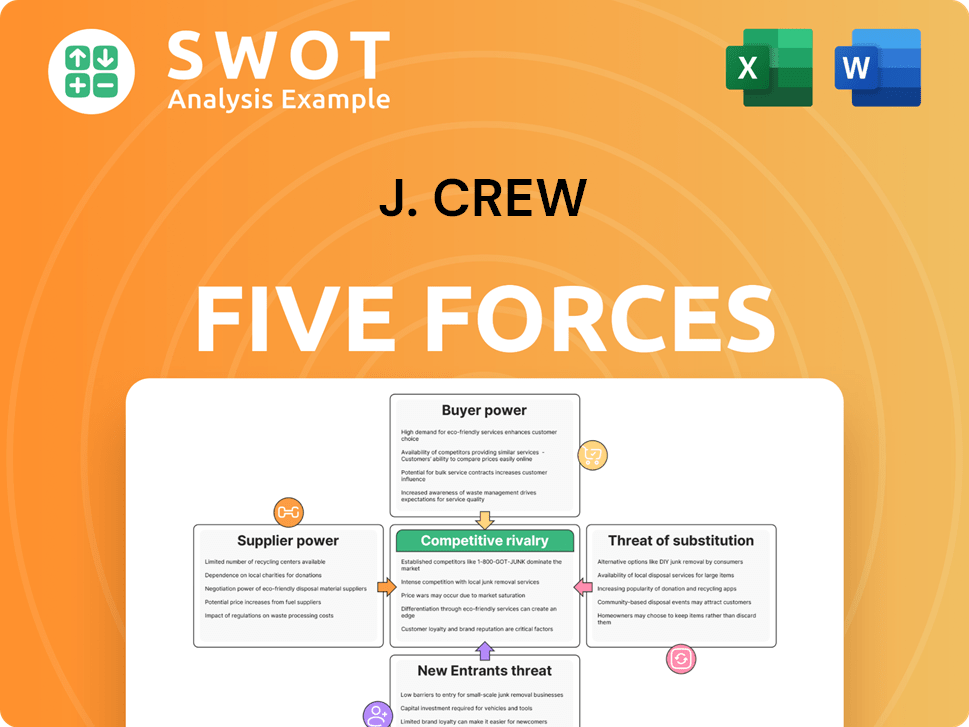J. Crew Bundle
Navigating the Fashion Battlefield: Who Stands Against J.Crew?
In the dynamic world of retail, understanding the J. Crew SWOT Analysis and its competitive landscape is crucial for any investor or strategist. J.Crew, a well-known name in the fashion industry, faces constant pressure from both established and emerging players. This analysis dives deep into the J. Crew competitive landscape, exploring its rivals and the strategies that define its position.

This exploration will provide a comprehensive J. Crew market analysis, identifying key J. Crew competitors and evaluating their impact on the brand. We'll dissect the J. Crew industry dynamics, examining how the company's J. Crew brand and J. Crew strategy are shaping its future amidst challenges like evolving consumer preferences and digital disruption. Ultimately, this analysis aims to equip you with the insights needed to assess J.Crew's potential in a fiercely contested market.
Where Does J. Crew’ Stand in the Current Market?
The J.Crew Group, encompassing the J.Crew, Madewell, and J.Crew Factory brands, carves out its niche in the specialty retail apparel sector. It focuses on consumers who appreciate classic, stylish designs, emphasizing quality and craftsmanship. The company operates within a highly competitive segment of the apparel industry, constantly vying for market share and consumer attention.
Madewell has been a significant growth driver, often outperforming the J.Crew brand and appealing to a younger, trend-conscious demographic. The company's product lines include women's, men's, and children's apparel, shoes, and accessories. Its geographical footprint is primarily in the United States, with a network of stores and robust online platforms.
The company has strategically shifted its positioning, notably with the revitalization of the J.Crew brand and the expansion of Madewell. This indicates a move to solidify its appeal across various customer segments. In fiscal year 2023, J.Crew Group reported total revenues of $2.52 billion, with J.Crew brand sales at $1.5 billion and Madewell sales at $907.4 million, demonstrating its significant scale within the industry. This financial performance, particularly Madewell's contribution, highlights its competitive standing.
J.Crew Group designs, sources, and sells apparel, shoes, and accessories. It operates through retail stores and online platforms, ensuring a multi-channel approach. The company's operations are centered around its core brands: J.Crew, Madewell, and J.Crew Factory.
J.Crew offers classic, stylish designs with a focus on quality and craftsmanship, appealing to consumers who value timeless fashion. Madewell targets a younger demographic with trend-conscious styles. J.Crew Factory provides value-oriented options.
J.Crew has a strong presence in the United States, with a network of stores and a significant online presence. Its international presence is more limited, representing a potential area for expansion. The company competes within the broader apparel market, facing competition from various retailers.
In fiscal year 2023, J.Crew Group's total revenues were $2.52 billion. Madewell's sales contributed significantly, reaching $907.4 million. The company's financial health, particularly the performance of Madewell, underscores its competitive standing within the industry.
The J. Crew competitive landscape is shaped by a diverse group of retailers. These competitors range from specialty apparel stores to mass-market retailers and online platforms. The J. Crew market analysis reveals a need to adapt to changing consumer preferences and market trends.
- Direct competitors include brands offering similar styles and price points, such as Banana Republic and Ann Taylor.
- Indirect competitors include fast-fashion retailers like Zara and H&M, which offer trend-driven apparel at lower price points.
- Online retailers and marketplaces, such as ASOS and Amazon, also pose significant competition.
- The company must continue to differentiate itself through design, quality, and brand experience.
J. Crew SWOT Analysis
- Complete SWOT Breakdown
- Fully Customizable
- Editable in Excel & Word
- Professional Formatting
- Investor-Ready Format

Who Are the Main Competitors Challenging J. Crew?
The Owners & Shareholders of J. Crew face a complex competitive landscape. The company navigates a market filled with diverse players, from established brands to fast-fashion retailers, all vying for consumer attention and market share. Understanding these competitors is crucial for evaluating the company's strategic positioning and potential for future growth.
The J. Crew competitive landscape is shaped by its positioning in the apparel industry, focusing on classic and contemporary styles. This focus places it in direct competition with brands offering similar aesthetics and quality. Moreover, it contends with broader market trends, including the rise of e-commerce and the evolving preferences of consumers.
The J. Crew market analysis must consider both direct and indirect competitors. Direct competitors offer similar products and target demographics, while indirect competitors challenge the company on price, speed to market, or target different segments. This multifaceted competition necessitates a comprehensive understanding of the strengths, weaknesses, and strategies of each player.
Direct competitors offer similar styles and target demographics. They compete directly with J. Crew for market share and customer loyalty. These brands often have established brand recognition and extensive retail footprints.
Indirect competitors challenge J. Crew on different fronts, such as price or speed to market. They may target different consumer segments or offer alternative value propositions. These competitors can impact J. Crew's market position.
Key players include major department stores and fast-fashion retailers. These entities have a significant impact on the apparel market. They offer diverse product ranges and compete on various factors, including price and style.
Emerging trends such as the rise of DTC brands and online marketplaces are reshaping the competitive landscape. These trends influence consumer behavior and market dynamics. Adapting to these changes is crucial for companies like J. Crew.
Understanding the competitive advantages of each player is essential for evaluating J. Crew's position. Factors such as brand legacy, retail presence, and marketing strategies play a crucial role. These advantages influence market share and customer loyalty.
Market share shifts are often driven by effective marketing campaigns and product launches. These shifts reflect the dynamic nature of the apparel industry. Analyzing these changes provides insights into competitive strategies and consumer preferences.
The J. Crew industry is highly competitive, with various players employing different strategies. J. Crew's brand competes with brands like Ralph Lauren, Brooks Brothers, and Tommy Hilfiger, which offer similar styles and target demographics. Fast-fashion retailers such as Zara and H&M compete on price and speed to market. DTC brands like Everlane and Reformation focus on online sales and sustainable practices. The competitive landscape is constantly evolving, influenced by factors such as consumer preferences, economic conditions, and technological advancements. J. Crew's strategy involves differentiating itself through its brand image, product quality, and customer experience, while also adapting to changing market dynamics.
- Ralph Lauren: Ralph Lauren's broad lifestyle offerings and global presence provide significant competition. In 2024, Ralph Lauren reported revenue of approximately $6.6 billion.
- Brooks Brothers: Brooks Brothers maintains a strong hold on the traditional American menswear market. The company's revenue was estimated at around $900 million in 2024.
- Tommy Hilfiger: Tommy Hilfiger, part of PVH Corp., competes with J. Crew in the contemporary apparel market. PVH Corp.'s revenue in 2024 was approximately $9.7 billion.
- Macy's: Macy's offers a wide assortment of brands, including private labels, often at competitive price points. Macy's reported revenue of around $23.1 billion in 2024.
- Zara: Zara, a fast-fashion retailer, challenges J. Crew on price and speed to market. Inditex, Zara's parent company, reported revenue of approximately €35.9 billion in 2024.
- H&M: H&M also competes with J. Crew by offering trendy items at lower prices. H&M's revenue in 2024 was approximately SEK 236 billion.
- Everlane: Everlane, a DTC brand, leverages online strategies and transparent pricing. Everlane's estimated revenue was around $300 million in 2024.
- Madewell: Madewell, within the J. Crew Group, has successfully captured a distinct segment of the market. The brand's revenue in 2024 was approximately $600 million.
J. Crew PESTLE Analysis
- Covers All 6 PESTLE Categories
- No Research Needed – Save Hours of Work
- Built by Experts, Trusted by Consultants
- Instant Download, Ready to Use
- 100% Editable, Fully Customizable

What Gives J. Crew a Competitive Edge Over Its Rivals?
The competitive landscape for J.Crew Group is shaped by its brand equity, design philosophy, and multi-channel retail strategy. The company has a strong brand recognition with a loyal customer base, particularly for its classic American aesthetic. Madewell, a subsidiary, contributes to a broader market reach through its focus on denim and casual wear. This dual-brand approach allows the company to capture a wider audience while maintaining distinct brand identities. Understanding the Marketing Strategy of J. Crew provides insights into how the company positions itself within this competitive environment.
J.Crew's vertically integrated business model is another key advantage, enabling greater control over design, production, and distribution. This model can lead to better quality control and quicker responses to market trends. Furthermore, the company's robust direct-to-consumer presence, through e-commerce and physical stores, offers customers flexibility and convenience. The focus on quality craftsmanship and materials differentiates it from fast-fashion competitors, appealing to consumers seeking durable, classic pieces.
The company's ability to consistently refresh its classic offerings while introducing new styles helps maintain customer engagement and loyalty. J.Crew leverages these advantages in its marketing by emphasizing lifestyle and aspirational imagery and in product development by focusing on versatile, enduring designs. However, the company faces challenges from competitors and shifts in consumer preferences, necessitating continuous adaptation and innovation to maintain its competitive edge.
J.Crew's established brand recognition and the perceived quality and timeless style associated with both J.Crew and Madewell brands are critical. The J.Crew brand cultivates a loyal customer base drawn to its classic American aesthetic. Madewell's focus on denim and contemporary casual wear appeals to a younger demographic, demonstrating robust growth.
This model provides greater control over design, production, and distribution. It contributes to quality control and potentially faster response times to market trends. The company benefits from a strong direct-to-consumer presence through its e-commerce platforms and a well-established network of physical stores.
J.Crew's multi-channel approach provides customers with flexibility in how they shop, enhancing convenience and brand accessibility. This includes a strong online presence and a network of physical stores. This strategy allows the company to engage with customers across various touchpoints.
The focus on quality craftsmanship and materials differentiates J.Crew from fast-fashion competitors. This appeals to consumers seeking more durable and classic pieces. The ability to refresh classic offerings while introducing new styles helps maintain customer engagement.
J.Crew's competitive advantages include strong brand recognition, a vertically integrated business model, and an omnichannel retail strategy. The company's focus on quality and classic styles differentiates it from competitors. These advantages are essential for navigating the dynamic fashion industry.
- Brand Equity: Strong brand recognition and loyal customer base.
- Vertical Integration: Control over design, production, and distribution.
- Omnichannel Presence: E-commerce and physical stores for customer convenience.
- Product Quality: Focus on craftsmanship and durable materials.
J. Crew Business Model Canvas
- Complete 9-Block Business Model Canvas
- Effortlessly Communicate Your Business Strategy
- Investor-Ready BMC Format
- 100% Editable and Customizable
- Clear and Structured Layout

What Industry Trends Are Reshaping J. Crew’s Competitive Landscape?
The apparel retail industry is currently experiencing significant shifts that impact the competitive landscape of companies like J. Crew. These include the rapid expansion of e-commerce, growing consumer interest in sustainable practices, and the influence of social media marketing. Technological advancements, such as AI-driven personalization, are also reshaping how retailers interact with customers, presenting both challenges and opportunities for J. Crew Group.
The ongoing digital transformation requires continuous investment in online platforms, supply chain optimization, and a seamless omnichannel experience to meet evolving consumer expectations. Understanding the Target Market of J. Crew and adapting to these trends is crucial for maintaining a competitive edge. This involves balancing brand heritage with innovative strategies to capture market share.
The apparel market is seeing a surge in e-commerce, with online sales projected to continue growing. Consumers are increasingly focused on sustainability and ethical production, influencing purchasing decisions. Social media and influencer marketing play a significant role in shaping brand perception and driving sales.
Navigating inflationary pressures and intense competition from both traditional and direct-to-consumer brands are key challenges. Maintaining brand distinctiveness and consistently innovating product offerings are critical. Potential declines in specific apparel categories and increased regulatory scrutiny also pose risks.
Expanding the Madewell brand into new categories and markets offers significant growth potential. Capitalizing on the demand for sustainable clothing through supply chain transparency is another avenue. Strategic partnerships and personalized shopping experiences driven by data analytics can also boost customer loyalty.
The J. Crew competitive landscape includes both direct competitors like Gap and indirect competitors such as fast-fashion retailers. The company's ability to adapt to trends, invest in digital capabilities, and maintain a strong brand identity is crucial for success. J. Crew's market analysis must consider evolving consumer preferences.
To stay competitive, J. Crew's strategy needs to focus on several key areas. This involves enhancing its digital presence and optimizing the supply chain for faster delivery. Furthermore, the company must consistently innovate its product offerings to meet evolving consumer demands.
- Investing in e-commerce platforms and omnichannel experiences.
- Expanding the Madewell brand and exploring new markets.
- Focusing on sustainability and ethical sourcing practices.
- Leveraging data analytics for personalized shopping experiences.
J. Crew Porter's Five Forces Analysis
- Covers All 5 Competitive Forces in Detail
- Structured for Consultants, Students, and Founders
- 100% Editable in Microsoft Word & Excel
- Instant Digital Download – Use Immediately
- Compatible with Mac & PC – Fully Unlocked

Related Blogs
- What are Mission Vision & Core Values of J. Crew Company?
- What is Growth Strategy and Future Prospects of J. Crew Company?
- How Does J. Crew Company Work?
- What is Sales and Marketing Strategy of J. Crew Company?
- What is Brief History of J. Crew Company?
- Who Owns J. Crew Company?
- What is Customer Demographics and Target Market of J. Crew Company?
Disclaimer
All information, articles, and product details provided on this website are for general informational and educational purposes only. We do not claim any ownership over, nor do we intend to infringe upon, any trademarks, copyrights, logos, brand names, or other intellectual property mentioned or depicted on this site. Such intellectual property remains the property of its respective owners, and any references here are made solely for identification or informational purposes, without implying any affiliation, endorsement, or partnership.
We make no representations or warranties, express or implied, regarding the accuracy, completeness, or suitability of any content or products presented. Nothing on this website should be construed as legal, tax, investment, financial, medical, or other professional advice. In addition, no part of this site—including articles or product references—constitutes a solicitation, recommendation, endorsement, advertisement, or offer to buy or sell any securities, franchises, or other financial instruments, particularly in jurisdictions where such activity would be unlawful.
All content is of a general nature and may not address the specific circumstances of any individual or entity. It is not a substitute for professional advice or services. Any actions you take based on the information provided here are strictly at your own risk. You accept full responsibility for any decisions or outcomes arising from your use of this website and agree to release us from any liability in connection with your use of, or reliance upon, the content or products found herein.